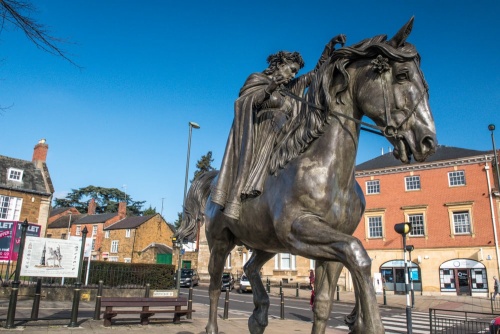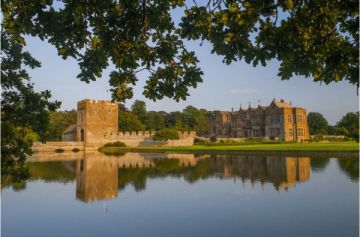
The Oxfordshire town of Banbury is known for the famous nursery rhyme, first published in 1784:
Ride a cock horse to Banbury Cross
To see a fine lady on her white horse
With rings on her fingers and bells on her toes
She shall have music wherever she goes.
So many parts of the rhyme remain a mystery. Which of [at least] three medieval crosses does the rhyme refer to? What is the 'cock horse'? And who, or what, is the 'fine lady' in the rhyme?
Some of those questions have at least plausible answers, though none is certain. The cock horse is often depicted as a hobby horse, a child's toy with the model of a horse's head atop a pole, or stick. Banbury holds an annual Hobby Horse Festival on the first weekend of July, with a parade of Hobby Horses and Hobby Horse races.

The Banbury Cross may refer to one of the three medieval crosses that are known to have existed in different locations around the town. The most likely candidate is the High Cross, in the market place. All three crosses were pulled down by Puritanical townsfolk in 1600. Today, plaques mark their most likely locations.
Banbury does have a cross today, but it is not the one referred to in the rhyme. It is a Victorian memorial in the form of a medieval Eleanor Cross, erected in 1859 to mark the marriage of Queen Victoria's eldest daughter to Prince Frederick of Prussia.
But who is the Fine Lady?
Her identity is a mystery, but that hasn't stopped writers from theorising. She has been identified as everything from a Celtic goddess to a 17th-century diarist and a May Queen.
Here are the candidates (that we know of).
- Rhiannon, the Welsh goddess of horses
- A May rider
- Queen Guinevere
- Lady Godiva
- Celia Fiennes
Let's take the last possibility first. Celia Fiennes (1662-1741) was a member of the Fiennes family of Broughton Castle, a few miles from Banbury. She made long horseback journeys around Britain and recorded her impressions of places she visited in her journals. These journals became extremely popular long after her death but hadn't gained much popularity at the time the rhyme was first published.
Lady Godiva (c. 980-1067) was an Anglo-Saxon noblewoman and the wife of Leofric, Earl of Mercia. The story of her naked ride through the streets of Coventry is as well known as the Banbury Cross nursery rhyme.
Queen Guinevere, wife of King Arthur. Both Arthur and Guinevere are legendary figures whose much-embellished stories are probably based on real historical characters, but she has no known connection with Banbury.
Rhiannon appears in The Mabinogion, the collection of Welsh stories, and is thought to be connected to the Gaulic horse goddess Epona. She is known for riding slowly and for being generous and bountiful.
The most likely candidate for the Fine Lady isn't a particular lady at all, but simply a representation of the annual May ride that took place in many communities around England in the medieval period. The May Day celebrations were remnants of earlier pagan tradition and were centred around fertility, rebirth, and the return of spring.

So closely linked is the nursery rhyme with the town of Banbury that attempts were made over many years to erect a Fine Lady statue to commemorate the connection. A project was launched to create a statue to honour Queen Elizabeth II's Golden Jubilee in 2002, but the £180,00 needed to fund the statue wasn't raised until three years later.
The statue was erected on 27 April 2005 and was unveiled by the Princess Royal. It shows the Fine Lady in the guise of a May Rider, or May Queen, her arm extended to strew flower petals. The woman's figure was designed by sculptors Carl Payne and Julian Jeffery, working together as Artcycle Ltd., and the horse was sculpted by Denise Dutton, who modelled the figure after a Welsh cob.
The Fine Lady wears a crown of thirteen flowers that bloom in spring, alternating daffodils and wild roses. Why thirteen? Because in the ancient system of lunar timekeeping there were thirteen months rather than the modern system of twelve months. A pair of butterflies and a moth hide amongst the flowers. She wears bells on her toes, but they are a mix of bluebell flowers and musical bells.
The statue is cast in bronze and stands on a plinth of locally quarried Hornton limestone.

Getting There
The Fine Lady Statue stands at the junction of South Bar Street (the A361) and West Bar Street (the B4035), a stone's throw from the Banbury Cross. There is parking along South Bar Street and Horse Fair.
About Fine Lady Statue, Banbury
Address: South Bar Street,
Banbury,
Oxfordshire,
England, OX16 0AH
Attraction Type: Historic Building - Statue
Location: At the junction of South Bar Street and West Bar Street, near Banbury Cross. Parking on South Bar Street and Horse Fair.
Website: Fine Lady Statue, Banbury
Location
map
OS: SP453403
Photo Credit: David Ross and Britain Express
NEARBY HISTORIC ATTRACTIONS
Heritage Rated from 1- 5 (low to exceptional) on historic interest
Banbury Cross - 0 miles (Historic Building) ![]()
Banbury, St Mary's Church - 0.1 miles (Historic Church) ![]()
Broughton Castle - 2.6 miles (Historic House) ![]()
Bloxham - 3.2 miles (Historic Church) ![]()
Adderbury, St Mary - 3.3 miles (Historic Church) ![]()
King's Sutton, St Peter & St Paul Church - 3.8 miles (Historic Church) ![]()
Swalcliffe Barn - 4.9 miles (Historic Building) ![]()
South Newington, St Peter ad Vincula Church - 5.2 miles (Historic Church) ![]()
Nearest Holiday Cottages to Fine Lady Statue, Banbury:
Hook Norton, Oxfordshire
Sleeps: 6
Stay from: £811.00 - 3854.00
More self catering near Fine Lady Statue, Banbury



